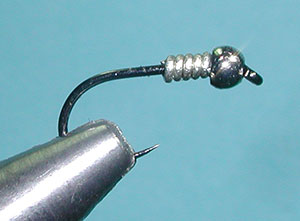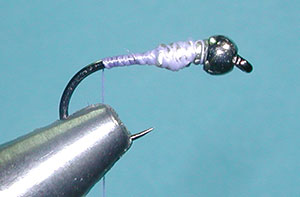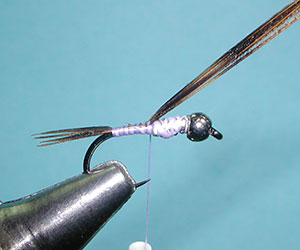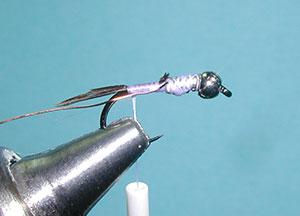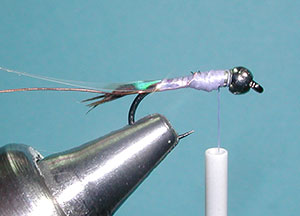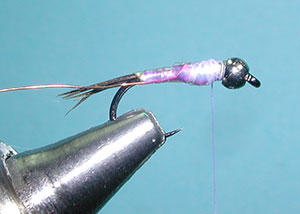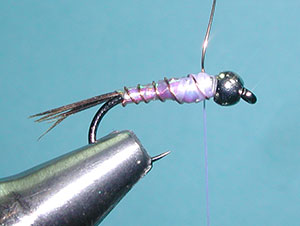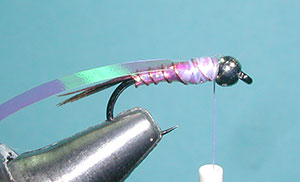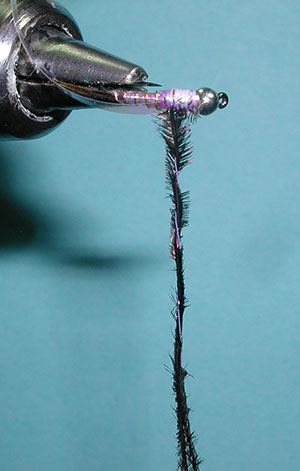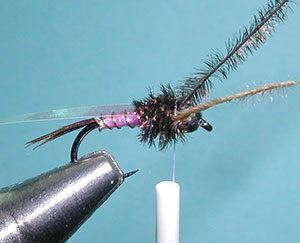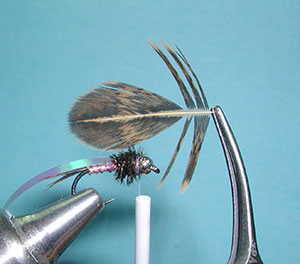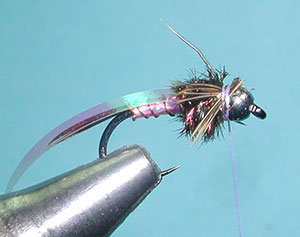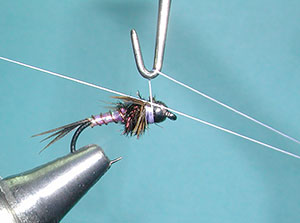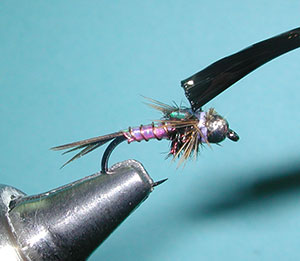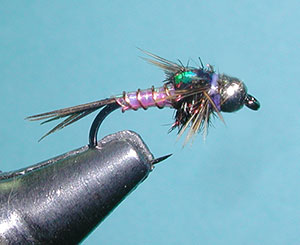Lightning Bug – improved with the flash of lightning

Lightning Bug
Tying Instructions
| Materials
to Order Material, click the link |
|
|---|---|
| Hook | Hanak 230BL, #12-16 |
| Thread | Veevus White 10/0 |
| Head | Gold Tungsten Bead |
| Weight | 0.020 Leadfree wire |
| Body | Pearlescent Mylar, Medium |
| Tail | Pheasant Tail Fibers |
| Thorax | Peacock Herl |
| Wingcase | Pearlescent Mylar, Medium |
| Legs | Brown Henback Hackle Fibers |
| Ribbing | Copper Wire, small |
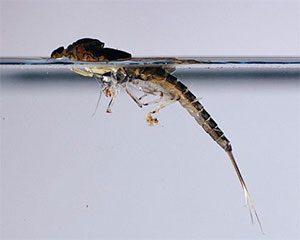
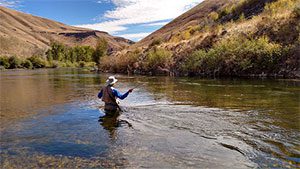
Yakima River
Lightning Bug
Developed by the late Larry Graham of Kirkland, WA in 1992, a noted fly tier and fly fishing guide. Larry Graham died of colon cancer on Nov. 27, 2002 . Originally, it was designed for the Yakima River but quickly became popular throughout most of the Western streams.
Flash and Brass
Brass beads became available for fly tying during the late 1980’s and Larry saw the advantage of designing a nymph utilizing the beadhead for quick descents. He desired some flash and used flashabou as a ribbing but found that it just was not durable. Larry resolved this problem by using flashabou for the abdomen and ribbing it with copper wire. As the design progressed, Larry used Pearlescent Mylar for the abdomen since it had a greater durability and came in different widths. The material also gave a subtle green coloration to the abdomen from the refraction of the brass colored hook.
Tailwater Pattern
A peacock thorax blended nicely with the greenish abdomen and legs were added using Brown Hen back hackle fibers. This greenish hue gives the pattern a good representation of green caddis larvae. The pattern was first published through Fly Tier magazine in Spring 1998 and a subsequent book by Leeson and Schollmeyer, “Trout Flies of the West” (1998).
The pattern is particularly good on tailwaters where it sinks quickly and attracts attention. The profile is similar to a Pheasant Tail Nymph yet it is considered an attractor pattern. Best results are found in riffles and runs where nymphs are prevalent. If the depth is not great, a single Lightning Bug beneath an indicator will work well. For deeper waters and faster currents, try using the Lightning Bug as a dropper with a heavier fly as the point. Since it is a bright fly pattern, it has a limited use during low flows when the water is clear and there are bright days.
Variations

John Mundinger
There are many variations of the Lightning Bug. John Mundinger came up with a nice variation enhancing the greenish color of the abdomen by using a chartreuse thread underbody with Chartreuse Ultra wire as rib over the Pearlescent Mylar. You may also find the use of Silver Mylar for the abdomen and the use of Hungarian Partridge as a soft hackle pattern.
Different colors of Holographic Tinsel are also available and color variations are made with these substitutions. Gold or Amber colorations may represent Pale Morning Duns. The thorax and legs are sometimes substituted with a synthetic dubbing which speeds up the tying process. Another touch to consider is a drop of epoxy on the wingcase as well as a thin application of epoxy on the abdomen without a wire ribbing.
The Pink variation has been found to be a popular color during the Winter months on our Sierran tailwaters, tied in a small size 18-20. The Purple coloration is a good choice during the Summer months in larger sizes of 14-16. Larger sizes of the Lightning Bug #8-12 are also used for Steelhead in Northern Calif. and the Northwest Rivers.
Variations
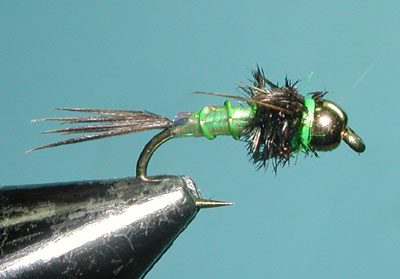
John Mundinger’s Lightning Bug
| Hook | TMC 3769 #14-18 |
| Thread | Danville Chartreuse 6/0 |
| Head | Gold Tungsten Bead |
| Underbody | Danville Chartreuse 6/0 |
| Body | Pearlescent Mylar, Medium |
| Tail | Pheasant Tail Fibers |
| Thorax | Peacock Herl |
| Wingcase | Pheasant Tail Barbs |
| Legs | Pheasant Tail Barbs |
| Ribbing | Chartreuse Ultra Wire |
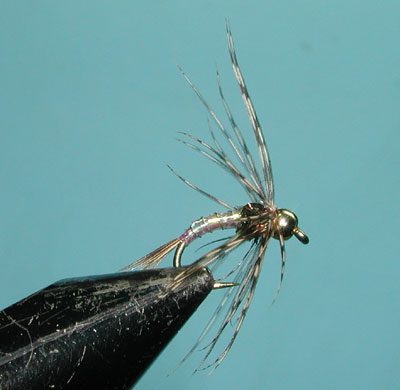
Soft Hackle Lightning Bug
| Hook | TMC 2457, #12-18 |
| Thread | Uni-thread Tan 8/0 |
| Head | Gold Bead |
| Body | Pearlescent Mylar, Medium |
| Tail | Pheasant Tail Fibers |
| Thorax | Peacock Herl |
| Wingcase | Pearlescent Mylar, Medium |
| Hackle | Partridge |
| Ribbing | Small Silver Wire |
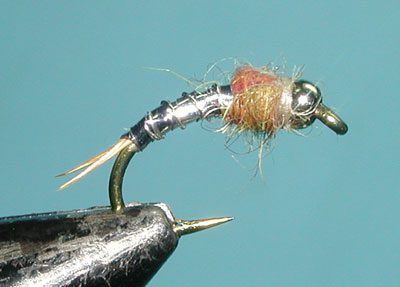
Orvis Lightning Bug
| Hook | TMC 2457, #12-18 |
| Thread | Uni-thread Tan 8/0 |
| Head | Silver Tungsten Bead |
| Body | Flat Silver Tinsel |
| Tail | Tan Turkey Biots |
| Thorax | Lt. Olive Brown Haretron Dubbing |
| Wingcase | Pearlescent Mylar, Medium |
| Ribbing | Small Silver Wire |
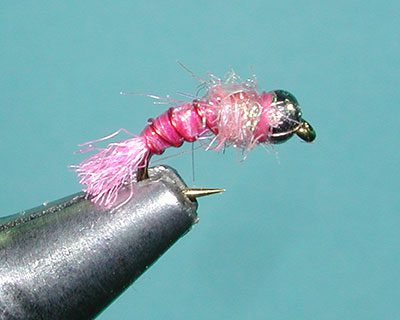
Pink Lightning Bug
| Hook | TMC 2457, #16-18 |
| Thread | Veevus 6/0 Pink |
| Head | Silver Tungsten Bead |
| Body | Pink Flashabou |
| Tail | McFlylon, Cerise |
| Thorax | Lightning Dub, Fl. Shrimp |
| Wingcase | Pearlescent Mylar, Medium |
| Ribbing | Small Red Wire |
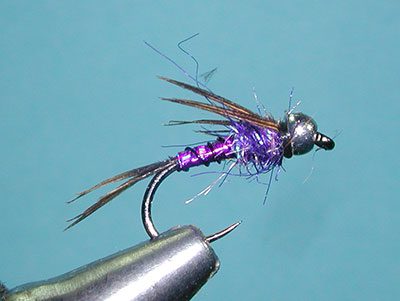
Purple Lightning Bug
| Hook | Hanak 230BL, #12-16 |
| Thread | Veevus 8/0 Black |
| Head | Silver Tungsten Bead |
| Body | Purple Holographic Tinsel |
| Tail | Pheasant Tail Fibers |
| Thorax | Lightning Dub, Fl. Shrimp and Lightning Dub, Purple |
| Wingcase | Pearlescent Mylar, Medium |
| Legs | Pheasant Tail Fibers |
| Ribbing | Small Black Wire |


